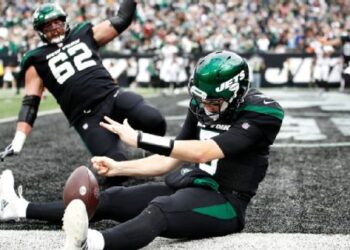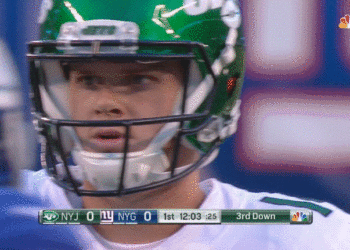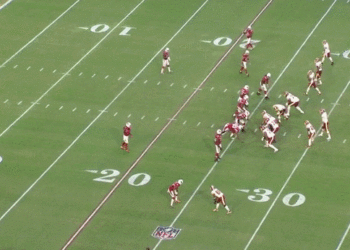Gase’s Offense: Tannehill/Osweiler Held Him Back (Part 6)
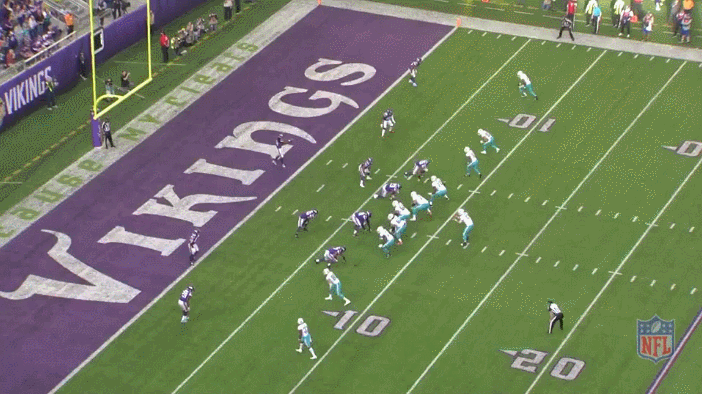
Welcome to part 6 of the series about the faults with Ryan Tannehill and Brock Osweiler, with regards to how it limited the effectiveness of Adam Gase’s offense. We will discuss the issues with the offense itself in a later series, while also discussing the bright spots within the same offense. Please don’t take this article as an excuse for Adam Gase, since he’s far from perfect, but this is just about how his quarterbacks held him back. Please check back with us for the rest of this series.
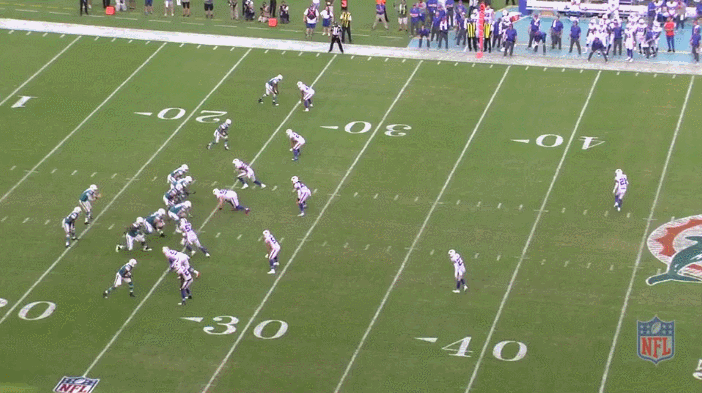
Another great example of bad QB play, albeit I don’t love this play call because there are two late developing routes down the field that are fairly close to each other. However, Tannehill has an easy pass to Parker on the play, while he’s crossing the middle, where there is a chance for yards after the catch. Notice how Tannehill doesn’t pull the trigger until the safety has closed the gap considerably. If this throw isn’t batted down, the safety has a shot at jumping the route and intercepting this pass. Once again, this is bad timing on the progression reads, because Tannehill is locked into late breaking routes, instead of scanning the routes that break first, and then moving on. The timing is built into the play call so Tannehill can look at Parker on the play, decide if he wants to take the chance for yards after the catch as an option to get the first down, or move onto the reads down the field. Instead, Tannehill sits on the late breaking routes, which are not open, and miss an opportunity to make the easy pass to Parker when he was open.
How does this impact the Jets? You can clearly see why Tannehill wasn’t a fit in the system, and why Gase wanted other QBs. I like Tannehill as an athlete, and on pure skills, he’s one of the better QBs in the game. However, the mental aspect of the game is completely lost on him (except when playing against Todd Bowles) and it holds back the whole offense.
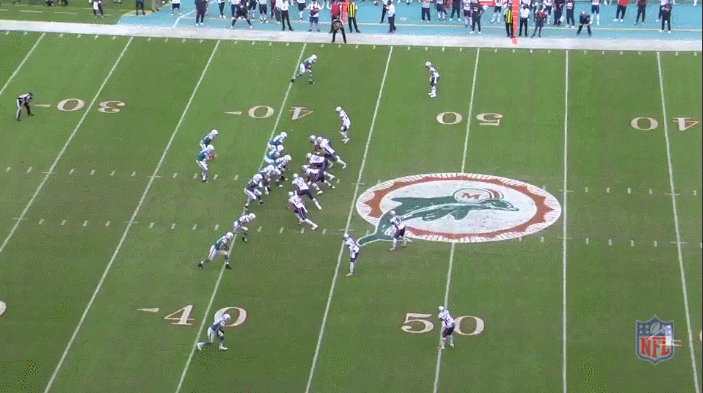
I’m surprised this throw wasn’t a pick six because Stephon Gilmore absolutely jumps the route. When I first watched this play, I didn’t really blame Tannehill as much because he’s about to get sacked so he just threw up a prayer to a one on one match up. However, if you dive in a bit deeper, you will see the issue with the progressions on a pre-snap read. The Patriots here are sending everyone after the QB, in a cover 0 look, which means every receiver has a one on one match up. However, on a full blown blitz situation, Tannehill’s first (and only read) is Parker. Essentially, he needs Parker to win the match up, because it’s a throw to Parker, throw the ball away, or get sacked situation. Why isn’t Tannehill reading the other side of the field, when he sees a full blitz. There is a built in hot route, intermediate route, and the exact same comeback route that Parker is running on the other side. You can also notice that Gilmore is playing much closer to Parker than the defender at the bottom of the screen, so the chances of a comeback route working increases with the larger gap. The call on this play could very well be Parker first, but Tannehill has to make the adjustment based on the defense.
How does this impact the Jets? This is one of the biggest areas to watch with the development of a young QB. You saw this blow up with Goff in the Super Bowl, where the Patriots essentially masked their defense until the headsets were turned off, and broke into a different shell to confuse the QB. A good young QB has to read at the line of scrimmage, and make adjustments or at the very least change route priorities. In this case, the QB needs to change the read priority from the left side to the right side because it’s a full blown blitz, so there won’t be any time to read Parker and then switch to the other side.
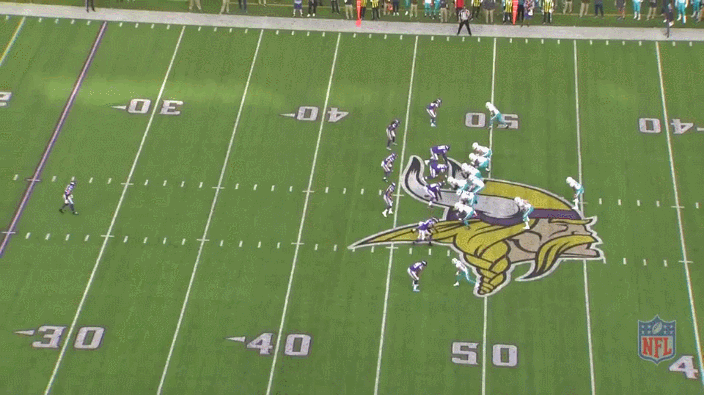
*Trigger Warning: Sack by Anthony Barr*
This play isn’t really that bad on part of the QB, but I thought it was a good microcosm of the problems facing Gase in that offense. One, the timing is off with the play action to begin with, because the running back is going out to block, while Tannehill makes a fake hand off to thin air. Second, Barr is rushing from the outside, and being blocked by the running back. The running back does the right thing to re-route him behind Tannehill, at which point the QB has to step up and to his left. Momentum will carry Barr past Tannehill, and the running back can slow down and still be a physical barrier between the rusher and QB. It’s especially vital in this case, because both of the routes break to the left side of Tannehill, so it makes more sense for him to slide closer to the passing lane. Instead, Tannehill hesitates with the move, which now causes the running back to be hesitant as well, at which point Barr cuts in and sacks the QB. I’m not saying that if Tannehill steps to his left, this would be a completed pass or any sort of successful play. It’s the play recognition, or the lack thereof, that I’m highlighting because Tannehill doesn’t seem to have pocket awareness at times. One other aspect, I hate this route concept because this is pretty much a one man route. The underneath route with Amendola is really the only possible option, because the route up top is running straight into the safety. It also highlights the talent issue with the offense, because they just can’t win one on one matchups often against talented defenses.
How does this impact the Jets? The first one is Bell, because he’s a very good pass blocker, so Darnold will have to know how Bell would block and work with him in tandem to evade pass rushers coming from the outside. The second is working on timing with Bell as well, because a play action to thin air doesn’t work on anyone, as the defenders can see the angles on the filed of play. The third, and quite possibly the most crucial aspect is the ability of receivers to win one on one matchups. Can Anderson, Enunwa, Crowder, Herndon consistently win one on one matchups? The Jets lack a true No. 1 WR that can win those matchups, and it might impact their draft strategy.
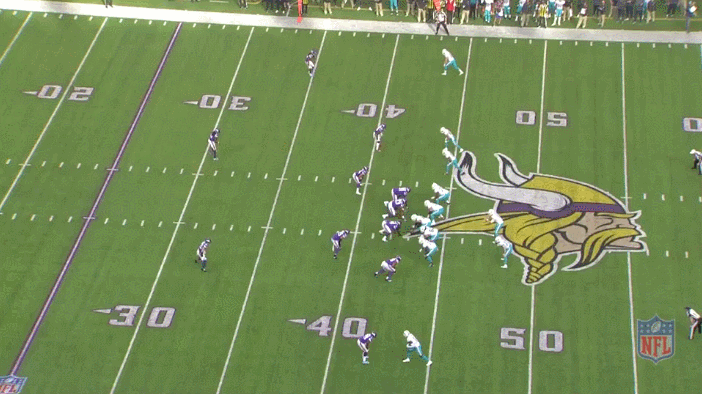
This goes for a 2 yard loss, but once again this is about bad progression reads, combined with bad mechanics. If you look at the end zone angle, you can clearly see that Tannehill is only looking at the middle linebacker before decides to throw this pass to Ballage. The issue is that he doesn’t see the slot cornerback in this scenario because he’s not making a good read. His first read should the slot cornerback or linebacker because they are horizontally in position to stop this screen pass to the running back. The read should have been to see the cornerback follow the slot receiver up the field, and then make a decision if you want to take the screen pass or the pass down the field. Tannehill gives away the plan before the slot cornerback has to turn his hips, and you can see the cornerback abandon his responsibility to the receiver. The early look to the running back allows the defense to get a head start on the play, and the slot cornerback blows it up. The play is designed so it’s a one on one match up between the middle linebacker and running back in the flats. The cornerback is not supposed to be part of the play until further down the field, but the lack of patience in reading the routes blows it up. To top it off, this jump pass is completely unnecessary in a situation where he has a clear passing lane and clean pocket.
How does this impact the Jets? Darnold is good at making reads, but the timing of those reads matter because every system is built around timing. There have been recent interviews where Gase has been antsy to work with Darnold, and the main issue is getting the timing of the offense down. The play calls for the most part is just verbiage, because there are a finite number of routes and route combinations. The issue is knowing the timing of those routes because Robby Anderson will go from Point A to B faster than Chris Herndon.
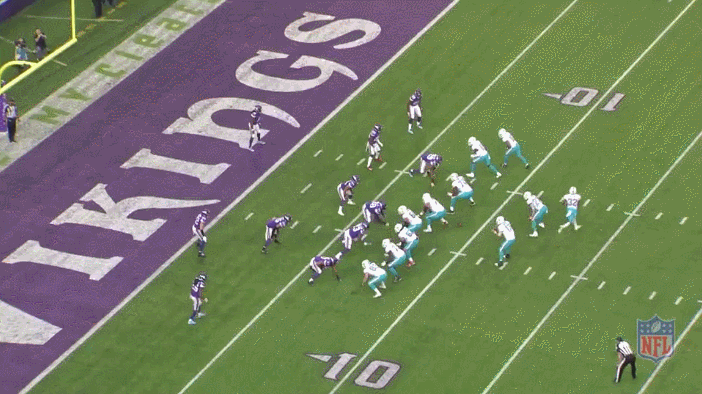
A possible touchdown is missed because of timing, as the tight end drops the ball after being hit. The play call is fairly simple, there is a running back in the flats with a two tiered slant route going right to left, with an underneath tight end route. The whole idea of this pass is that it goes right down the middle of the hashes, but Tannehill waits until the players cross to throw the pass. This should have been thrown to the tight end or the slot receiver earlier, but he hesitates. I don’t love the route combination here, but it leads to two wide open receivers, but Tannehill doesn’t pick right. If the tight end is the option, you throw the pass before they cross because he’s running the shallower route, therefore the receiver isn’t going to try and catch the ball away from the tight end. Once they cross, the receiver should be the target because he has a second receiver running behind him blocking direct path by the defender. Instead, Tannehill chooses the tight end option, after they cross each other, which leads the tight end towards a defender. He probably should have held onto the ball, but this is a play that worked beautifully, only to have been ruined by hesitation.
How does this impact the Jets? Decisiveness is key in any system but you can clearly see how Gase’s system isn’t fully displayed because he has a QB that just can’t process things quickly. If Darnold can process plays quicker, then it should be much more productive than any of the seasons from Tannehill.

An easy touchdown throw, that ends up being an incomplete pass because once again Tannehill hesitates at a moment he needs to throw the football. Notice that Amendola is wide open the moment he makes his cut to the outside, and that’s when Tannehill should make the throw. However, he hangs on for extra time, and the throws it low for an incomplete pass anyway. The timing difference isn’t major, but this is what most scouts are talking about when guys throw with anticipation. If you throw with anticipation, you are ready to throw the moment Amendola makes the break to the outside. If you need to see him open first, and then make the throw, you wait. A lot of spread college systems allow you to wait until a player is open before you have to decide, which is where the concerns about transitioning to a more anticipatory system come about.
How does this impact the Jets? I feel like I’m beating a dead horse here, because for some odd reason I had an idea to write “How does this impact the Jets” after every clip a few hours ago. Once again, this impacts Darnold the most, and how he can get the timing of the system down. They didn’t score a touchdown on this drive by the way.
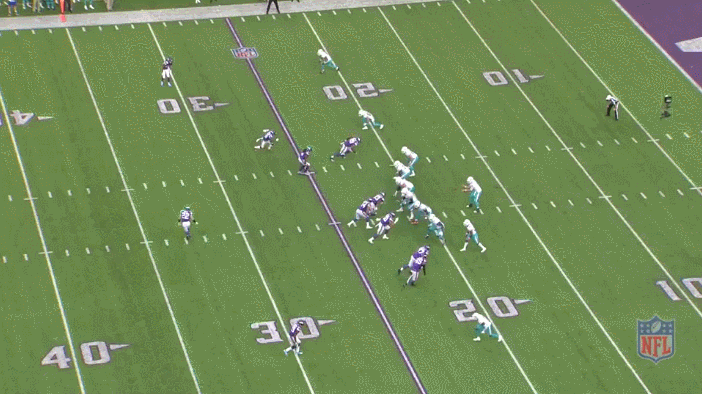
The lack of pocket awareness from Tannehill is infuriating to watch at times because he makes situations harder for himself. On this play, all he really has to do is step up in the pocket and make a pass with firm footing. The moment he takes two steps up in the pocket, he has a crossing route that is open, a go route to his right that is wide open, or a post route to his left that is becoming open. If he makes any of these reads while having his feet planted, he could make an excellent throw. However. Tannehill keeps running as the gap between him and the defenders close in, only to make an errant throw while being completely off-balance. I’m not saying this is the perfect play call, but this once again points to Tannehill having a tendency to make off-balance throws, that usually don’t end well.
How does this impact the Jets? I keep thinking back to the touchdown against the Bills to Robby Anderson with Darnold running around. He was being chased by defenders around the field, but he kept his eyes down the field and it paid off. In this case, I think Tannehill locked onto one receiver and waited until the last moment to make a terrible throw.
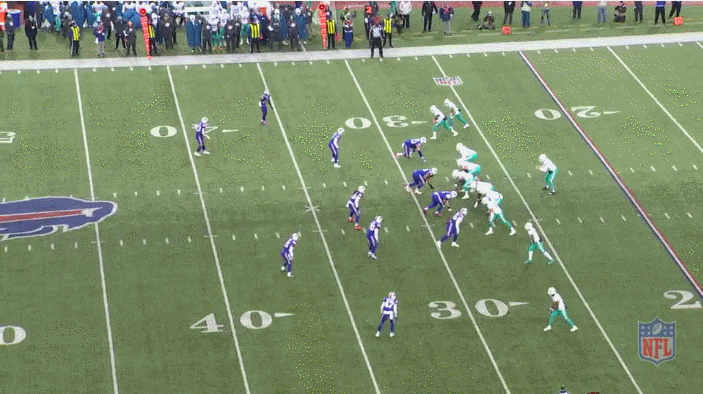
First of all, this is a great interception from the Bills linebacker, as he plucks this pass out of the air with one hand. However, this is a horrible display by Tannehill on QB competency. The first issue here is timing as usual, because you can clearly see Tannehill lock onto his receiver early. He starts his backpedal by looking to the left side, but comes off the read early. He flips to the other side before the slot receiver to his left makes the cut, and the middle linebacker notices this. The linebacker doesn’t follow the receiver to the outside, but the route concept is supposed to hold that linebacker to that side of the field for an extra second. Second, notice the timing of the cut for the eventual intended receiver, as he gets off the line slowly. The whole intention is to undercut the right slot receiver, but also set up timing where Tannehill could look to the left side, and then turn to the right side as this receiver hits his stride. Instead, Tannehill locks in early, at which point the cornerback and middle linebacker realize the target and all but lock him down. Third, this throw is just way off, even though it’s not evident from this angle. This would have been an incomplete pass if the entire defense had just sat down at the snap. Furthermore, there is a deep post route and wheel route with one on one matchups opening up with a clean pocket, but Tannehill is locked in on this receiver from the start.
How does this impact the Jets? On the outset, this looks like a clear failed play from Adam Gase, because the intended receiver is well covered, and there aren’t wide open guys running down the field. However, Tannehill causes this interception with a terrible throw, horrible progression timing, and locking in on a receiver too early.
Thanks for reading Part 6 of our Gase’s Offense: Tannehill/Osweiler Held Him Back series. Please check back for the conclusion and final part soon.
Videos
Malachi Moore All-22 Review: The Jets Next "Star" Defender?


